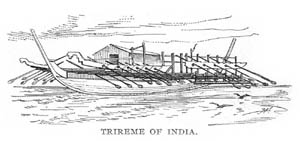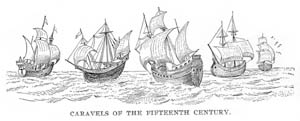|
CHAPTER IV.
EARLY NAVIGATORS AND EXAMPLES OF THEIR MONSTER VESSELS.
THOSE who have little familiarity with the gigantic accomplishments of very ancient peoples, and who make their estimates of civilization from the lofty plateau of the nineteenth century, stand amazed before evidences of greatness equalling our own which has long since passed away, and which, except to those who are able to read the almost faded record, left no memorials of their existence. Thus the casual reader will declare that a passage of the Atlantic was impossible before the days of Columbus, because even at that period ship-building had produced nothing beyond the caravel, a craft in which only the most venturesome would trust themselves. But if surprise and doubt has been excited by the revelations herein made respecting the exploitations of pre-Columbian navigators, let wonder at their achievements subside when the facts are made to appear that even our largest modern ocean steamers scarcely exceed in size some of the vessels that were built thousands of years ago.
The Ark, whatever may have been its shape, from dimensions given must have had a tonnage of 15,000, not quite so large as the Great Eastern, but fully 4500 tons greater than the City of Paris, which is the mammoth of existing ships. And a singular fact herein also appears, viz.: that the Ark was, according to Scripture, 450 feet in length, 75 feet in breadth, and 45 feet depth of hold, which are the identical proportions of our best modern vessels.
But if there be some who refuse to accept Biblical authority, their doubts that the ancients built ships of gigantic size must be dissipated before well authenticated facts of profane history which I will here introduce:
 |
Egypt is a country remarkable for its stupendous works; but the greatness and resourcefulness of the Egyptians are not only to be seen in pyramid, obelisk, sphinx and colossus, for sculpture and hieroglyphic reveal the nation in marvellous advancement. Thus, in one of the ruined palaces of Thebes, there is a stone which was originally a facing of the exterior, on which, among other heroic sculpturing, we perceive a representation of Rameses III (about 1250 B.C.) watching a naval battle, in which the Egyptian fleet is engaging the battle-ships of the Shardana and Takkara, and from the number of galleys shown, some of the vessels must have been of very great size.
 |
Ptolemy IV., Philopator (B.C. 222), was an enthusiastic admirer of the navy, in which he placed the greatest reliance as the chief defence and promoter of the interests of his kingdom. Of the many large ships which he constructed, the dimensions of one have been preserved to history, and were as follows: Length, 420 feet; breadth, 57 feet; and from keel to highest point of poop-deck, 72 feet. This immense vessel was propelled by 4000 rowers, besides which she had a crew of 3000 marines, and a great number of servants. The oars used in propelling her were 67 feet in length, and with handles loaded with lead, so that they balanced so perfectly that a child might easily move them. She was also provided with four steering pars, 45 feet long, which swung upon pivots with equal facility. To afford space for the 2000 rowers on each side, the ship's decks were terraced into five banks, so that 400 rowers sat on each deck, which, if true, must have necessitated the use of oars of different length for each bank. History, after describing this monster ship, mentions the fact that she was launched and used on more than one occasion for display, but it is doubtful if she was ever put to any useful service.
 |
Another ship, called the Thalamegus, was built by the succeeding Ptolemy, which, while somewhat restricted in dimensions to 300 feet in length, 40 feet beam, and 60 feet from keel to top-deck, greatly exceeded the former in bewildering magnificence. Callixenus, the Alexandrian historian, gives us an intimation of her splendor by saying that she was provided with colonnades, marble stairs and hanging gardens.
Hiero, king of Syracuse (307 B.C.), was also a distinguished patron of ship-building. At the opening of the second Punic War, he built and sent to sea a great fleet, and afterwards had constructed a vessel which for size, convenience and perfection of details, may favorably compare with the finest and largest vessels of our own times. From the imperfect and too brief descriptions left by historians, we learn that Hiero's great ship had three cabins, or decks, the lowest, which was really the hold, being for freight, the second for soldiers and a dining saloon, and the upper used by the officers for quarters, and as a promenade-deck. All the floors of the rooms and cabins were artistically laid in mosaic work of colored marble, and in the grand salon, which was in the after-part
 |
of the main cabin, there was a gracefully carved temple beautifully inlaid with ivory and gold, and dedicated to Venus. The extraordinary size of this vessel, in the absence of recorded dimensions, may be reasonably conjectured by the aid of such facts as are given. The mainmast is said to have been made of a single tree, which might readily have been done, as masts were short in all the early ships, and carried only a single sail. Her freight capacity is declared to have been sixty thousand measures of corn (40,000 bushels), ten thousand jars of Sicilian salt fish, twenty thousand talents' weight of wool, and twenty thousand talents' weight of bulk cargo, the whole being equal to about 11,000 tons, which is 500 tons greater than the largest craft now in service; but in addition to her capacity as a carrier of merchandise, she carried two launches on her deck, each with a capacity of eighty tons, besides vast stores of provisions, and four wooden and eight iron anchors, all of which are suggestive of a size far greater than her capacity would appear to indicate, and beside which the caravels of Columbus's time would hardly assume the importance of yawls.
Under these revelations, we must admit that the galleys and triremes (three-banked and many-decked ships) of the so-called ancients, so often referred to, were but coasting boats, and that they were not in fact such vessels as composed the great navies of ancient Egypt, Phoenicia, Carthage and Greece, either for war purposes or for extended voyages.
|





